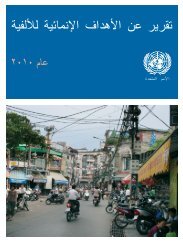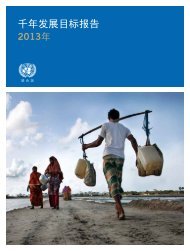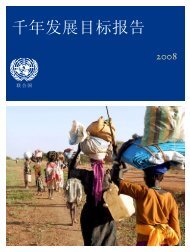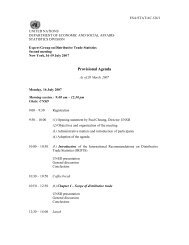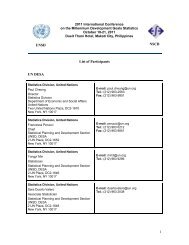Overview of the process for data compilation, adjustments, indicator ...
Overview of the process for data compilation, adjustments, indicator ...
Overview of the process for data compilation, adjustments, indicator ...
Create successful ePaper yourself
Turn your PDF publications into a flip-book with our unique Google optimized e-Paper software.
Monitoring MDG 5.B Indicators on<br />
Reproductive Health<br />
UN Population Division and UNFPA<br />
9-13 July 2012<br />
UNSD/ESCAP Workshop on MDG Monitoring, Bangkok
MDG 5. Improve maternal health<br />
• Target 5.B: Achieve, by 2015, universal<br />
access to reproductive health<br />
– Indicator 5.3 Contraceptive prevalence<br />
rate<br />
– Indicator 5.4 Adolescent birth rate<br />
– Indicator 5.6 Unmet need <strong>for</strong> family<br />
planning
Rationale<br />
Preventing unwanted pregnancy and<br />
childbearing at young ages<br />
– Health implications (reduce maternal<br />
deaths, improve infant survival)<br />
– Social and economic development<br />
implications<br />
– Rights implications
Source: Ahmed et al. 2012. The Lancet, doi:10.1016/S0140-6736(12)60478-4
<strong>Overview</strong><br />
• Definition and methods <strong>of</strong> computation<br />
• Data sources and availability<br />
• Data limitations, including comparability<br />
• Estimation <strong>of</strong> regional and global averages
Indicator 5.3<br />
Contraceptive prevalence rate
Indicator 5.3 Contraceptive prevalence<br />
Definition<br />
• The percentage <strong>of</strong> women married or inunion<br />
aged 15 to 49 who are currently<br />
using, or whose sexual partner is using, at<br />
least one method <strong>of</strong> contraception,<br />
regardless <strong>of</strong> <strong>the</strong> method used.
Definition: Methods<br />
• Any method, modern methods, condom use<br />
• Modern methods: female and male sterilization,<br />
oral hormonal pills, <strong>the</strong> intra-uterine device (IUD),<br />
condoms, injectables, implants, vaginal barrier<br />
methods and emergency contraception.<br />
• Traditional methods: rhythm, withdrawal,<br />
lactational amenorrhea method (LAM) and folk<br />
methods.
Data<br />
• Nationally-representative survey <strong>data</strong><br />
• Administrative <strong>data</strong> sources not used<br />
– Difficult comparability<br />
– Miss traditional method use<br />
– Miss private sector sources (shops)
Obtaining survey <strong>data</strong><br />
• Published reports from<br />
– Demographic and Health Surveys (DHS)<br />
– Reproductive Health Surveys (RHS)<br />
– Multiple Indicator Cluster Surveys<br />
(MICS)<br />
– Fertility and Family Surveys (FFS)<br />
– O<strong>the</strong>r nationally-sponsored surveys
Comprehensive <strong>data</strong> on<br />
contraceptive prevalence<br />
www.unpopulation.org
Indicator 5.3 Contraceptive prevalence<br />
Data availability
Limitations <strong>of</strong> <strong>data</strong><br />
• Characteristics <strong>of</strong> reference population<br />
• Time frame used to assess contraceptive<br />
prevalence<br />
• Survey question variability and effect on<br />
reporting
Data point selection<br />
• MDG <strong>data</strong>base: One point per year<br />
– Married or in-union women aged 15 to 49<br />
– Next most comparable group (sexuallyactive<br />
women; ever-married women)<br />
• If no <strong>data</strong> on current use, <strong>data</strong> on use at<br />
last sexual intercourse or during <strong>the</strong><br />
previous year.
Trends in contraceptive prevalence<br />
since 1990<br />
Bangladesh Bhutan Cambodia
Trends in contraceptive prevalence<br />
since 1990<br />
China Indonesia Iran
Trends in contraceptive prevalence<br />
since 1990<br />
Lao Mongolia Myanmar
Trends in contraceptive prevalence<br />
since 1990<br />
Nepal Pakistan Papua New<br />
Guinea
Trends in contraceptive prevalence<br />
since 1990<br />
Philippines Thailand Afghanistan
Common reasons <strong>for</strong> discrepancies<br />
• Different survey <strong>data</strong> sources<br />
• Modifications in <strong>the</strong> case <strong>of</strong> known errors in<br />
<strong>the</strong> reported figures<br />
• For MDG <strong>data</strong>base, modern methods do<br />
not include LAM or folk methods
Regional and global estimates
Contraceptive prevalence<br />
1990 and 2010
Indicator 5.6<br />
Unmet need <strong>for</strong> family planning
Indicator 5.6 Unmet need <strong>for</strong> FP<br />
Definition<br />
• Women who want to delay or stop<br />
childbearing but are not using any method<br />
<strong>of</strong> contraception.<br />
• Unmet need is <strong>the</strong> gap between women's<br />
reproductive intentions and <strong>the</strong>ir<br />
contraceptive behaviour.
Method <strong>of</strong> computation<br />
• Numerator: Women who are...<br />
– married or in union, aged 15-49<br />
– fecund<br />
– not using any method <strong>of</strong> contraception<br />
– not wanting any more children or wanting<br />
to delay <strong>the</strong> next child <strong>for</strong> 2+ years<br />
• Denominator: Married or in-union women<br />
aged 15-49
http://mdgs.un.org
Data<br />
• Nationally-representative sample survey<br />
<strong>data</strong> from <strong>the</strong> DHS, RHS and national<br />
surveys that<br />
– Are based on similar methodologies<br />
– Include detailed questions to identify<br />
population at risk<br />
• Differences in definition used are flagged<br />
with footnotes in <strong>the</strong> <strong>data</strong> series.
Indicator 5.6 Unmet need <strong>for</strong> family<br />
planning -- Data availability
Number <strong>of</strong> MDG <strong>data</strong> points on unmet<br />
need by <strong>data</strong> source
Comparison <strong>of</strong> unmet need<br />
computation (old and revised)<br />
Nepal<br />
Indonesia<br />
Philippines<br />
Source: Bradley et al. 2012; See also http://measuredhs.com/Topics/Unmet-Need.cfm
Common reasons <strong>for</strong> discrepancies<br />
• Use <strong>of</strong> old versus revised computation <strong>of</strong><br />
unmet need (<strong>for</strong> DHS <strong>data</strong>)<br />
• Different computations from same source<br />
(surveys o<strong>the</strong>r than DHS)<br />
• Different survey <strong>data</strong> sources
Unmet need <strong>for</strong> family planning,<br />
1990 and 2010<br />
Eastern Asia<br />
4<br />
LAC<br />
10<br />
Nor<strong>the</strong>rn Africa<br />
South-eastern Asia<br />
Caucasus and Central Asia<br />
12<br />
13<br />
13<br />
1990<br />
2010<br />
Sou<strong>the</strong>rn Asia<br />
Western Asia<br />
16<br />
17<br />
Sub-Saharan Africa<br />
25<br />
0 10 20 30 40 50
Indicator 5.4<br />
Adolescent birth rate
Indicator 5.4 Adolescent birth rate<br />
Definition<br />
• The annual number <strong>of</strong> births to women 15<br />
to 19 years <strong>of</strong> age per 1,000 women in that<br />
age group.<br />
• Represents <strong>the</strong> risk <strong>of</strong> childbearing among<br />
adolescent women 15 to 19 years <strong>of</strong> age.<br />
• Also referred to as <strong>the</strong> age-specific fertility<br />
rate <strong>for</strong> women aged 15-19.
Method <strong>of</strong> computation<br />
• A ratio<br />
– Numerator: Number <strong>of</strong> live births to<br />
women 15 to 19 years <strong>of</strong> age<br />
– Denominator: Number <strong>of</strong> women 15 to 19<br />
years <strong>of</strong> age<br />
• Calculated differently <strong>for</strong> civil registration,<br />
survey and census <strong>data</strong>.
Data sources<br />
• Civil registration <strong>data</strong><br />
• Surveys<br />
• Censuses
Civil registration <strong>data</strong><br />
• Used if registration systems cover 90 per<br />
cent or more <strong>of</strong> all live births.<br />
• Priority <strong>of</strong> sources <strong>for</strong> number <strong>of</strong> births<br />
• UN estimate <strong>of</strong> number <strong>of</strong> women (from<br />
World Population Prospects) --<br />
www.unpopulation.org
www.unpopulation.<br />
org
Survey and census <strong>data</strong><br />
• Used if no civil registration system or where<br />
system coverage < 90 per cent <strong>of</strong> all live births.<br />
• Surveys: Birth history <strong>data</strong> (reference period and<br />
year ~2.5 years be<strong>for</strong>e survey interview)<br />
• Census: Provides both <strong>the</strong> numerator and <strong>the</strong><br />
denominator <strong>for</strong> <strong>the</strong> rates
Obtaining <strong>data</strong><br />
• Civil registration <strong>data</strong>: UNSD, regional<br />
Statistics Divisions or statistical units<br />
• Surveys: DHS, RHS, MICS, o<strong>the</strong>r national<br />
surveys<br />
• Censuses: Estimates from published<br />
reports, adjusted rates only when reported<br />
by National Statistical Office.
Indicator 5.4 Adolescent birth rate<br />
Data availability
Data limitations<br />
• Civil registration <strong>data</strong>:<br />
– Completeness <strong>of</strong> birth registration<br />
– Accuracy <strong>of</strong> age <strong>of</strong> mo<strong>the</strong>r <strong>data</strong><br />
– O<strong>the</strong>r<br />
• Survey and census <strong>data</strong>:<br />
– Age and date misreporting<br />
– Birth omissions and displacements<br />
– Sampling variability (surveys)
Common reasons <strong>for</strong> discrepancies<br />
• WPP population estimate vs. o<strong>the</strong>r <strong>data</strong><br />
<strong>for</strong> denominator<br />
• Inclusion <strong>of</strong> births to women under 15<br />
years <strong>of</strong> age<br />
• Different reference periods used<br />
• Different <strong>data</strong> source selected
Thank you!<br />
www.unpopulation.org<br />
http://mdgs.un.org
Indicator 5.4 Adolescent birth rate<br />
Nepal






